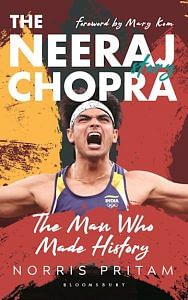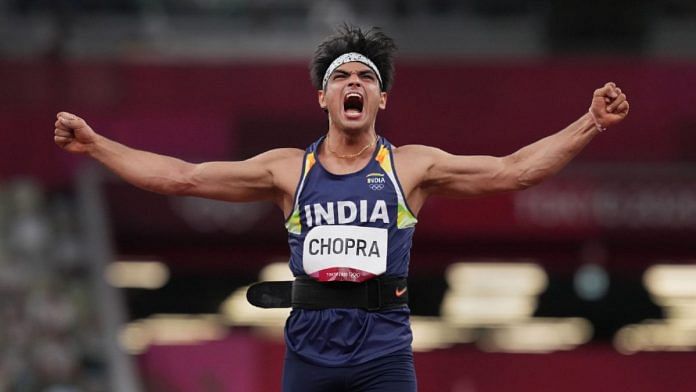Neeraj was not born into a sporting family. In fact, no one in his large joint family had a clue about any kind of sport, least of all organized sport. The only fields Neeraj saw in his childhood were the ones that belonged to his family of farmers. There was no question of exposure to any organized or competitive sport. He often speaks about his accidental entry into athletics and javelin throw, and how he took up the sport because he was overweight and wanted to be fit. With the benefit of hindsight, one should be grateful to his paternal grandmother. If it wasn’t for her, he would not have been overweight and tried to get in shape. Perhaps, he wouldn’t even have seen a javelin in his life. And India would have been poorer by a historic gold medal.
While conceptualizing this book, sometime after he won the gold, meeting Neeraj was obviously high on my agenda. But he was busy attending felicitations across the country and I had no access to him. I tried some sources and contacts but nothing worked. So I decided to meet all the stakeholders in his journey to the Olympic podium. Since Neeraj was part of the national camp at NIS, Patiala, I decided to begin with his family in the village of Khandra in Panipat, Haryana. Obviously, I was excited at the prospect of being face-to-face with an Indian Olympic champion, but due to professional compulsions I did not share my excitement with anybody except my wife.
I spent the next fortnight assembling my thoughts and strategy to start writing. Finally, I embarked on the journey to Panipat to meet his parents and friends. Two of my friends also came along. Soon after entering Haryana, we stopped for lunch at a roadside dhaba. In between crisp, hot tandoori roti and dal fry, we began speculating whether Neeraj would be home for Diwali. There was heavy holiday traffic on the way, and by the time we reached Panipat it was almost evening. And Khandra was still a forty-minute drive from Panipat city. On entering the village periphery, we found several hoardings welcoming Neeraj. They had been put up before his arrival from Tokyo but were still there. It was evident that the historic Third Battle of Panipat and the bedcovers and pickles the city is known for were not the only Panipat landmarks anymore. Brand Neeraj had taken over!
We reached his house, where some village elders were enjoying their evening hookah. They welcomed us and we began chatting. It was actually a traditional baithak or an outhouse where menfolk of the household sit and chat. We spent an hour talking to Neeraj’s Chacha Bhim, the self-appointed spokesperson for the Olympic champion. Contrary to many people’s warnings before leaving Delhi, I found Bhim to be nice and friendly. But during the long conversation, my mind was hovering around Neeraj. I even requested Bhim to arrange a meeting with him. On this he was non-committal.
As the night was approaching, we got ready to leave for Delhi. But Bhim insisted that we stay for dinner. He led us to the palatial double-storied mansion, the abode of the new Olympic champion. To my great surprise and extreme joy, Neeraj was the first person I saw as I entered the well-decorated drawing room. It was simply unbelievable. I rushed forward to shake hands with him, but before I could do that, he bent down and touched my feet despite my resistance. A few minutes later, I realized he was no ordinary young man. Over four decades of covering sport—mainly athletics—I have met great Olympic champions and multiple medallists like Emil Zatopek, Kip Keino, Edwin Moses and Sebastian Coe, among others. They were all humble. But our own Made-in-India Olympic champion outdid them when it came to humility.
His joint family of nineteen members greeted us with affection, and Neeraj even insisted on us staying back. During our conversations, Neeraj would also engage with some of his schoolmates who had gathered there to greet him. Chacha Bhim began recalling, ‘As soon as he would come back from school, his dadi, Nattho Devi, would make him sit on her lap and feed him a bowl of pure milk and another of thick cream with lots of sugar. So many times we told her that he was growing sideways and putting on weight. Imagine a thirteen-yearold boy weighing 85 kg. But she would have none of it. After eating, he used to sleep on her lap.’
Neeraj had become the butt of jokes in the village. Boys would tease him. ‘They used to call him sarpanch [village head],’ added Surender, a close buddy of Neeraj. ‘He used to be angry and would feel bad.’ Neeraj’s three uncles and his father, Satish Kumar, spoke to their mother and arranged to send him to a nearby gym. His youngest chacha, Surender, who is seven or eight years older than Neeraj, was asked to take him to the gym. Neeraj did lose some weight, but as luck would have it the gym soon shut down.
‘Then I took him to Panipat and arranged a personal trainer, Jitender, for him. Within four months he showed progress and he had trimmed down,’ recalled Surender. In Panipat’s Shivaji Stadium, Neeraj saw some of his seniors throwing the javelin. ‘I was fascinated by its flight and wanted to throw it,’ said Neeraj. He also made friends with coach Jaiveer and para athlete Narender Ranbir. One day, Jaiveer asked him to throw a javelin. And his maiden throw was so impressive that Jaiveer asked him to continue as a javelin thrower. His journey began that day.
 This excerpt from Norris Pritam’s ‘The Man Who Made History: The Neeraj Chopra Story’ has been published with permission from Bloomsbury India.
This excerpt from Norris Pritam’s ‘The Man Who Made History: The Neeraj Chopra Story’ has been published with permission from Bloomsbury India.



